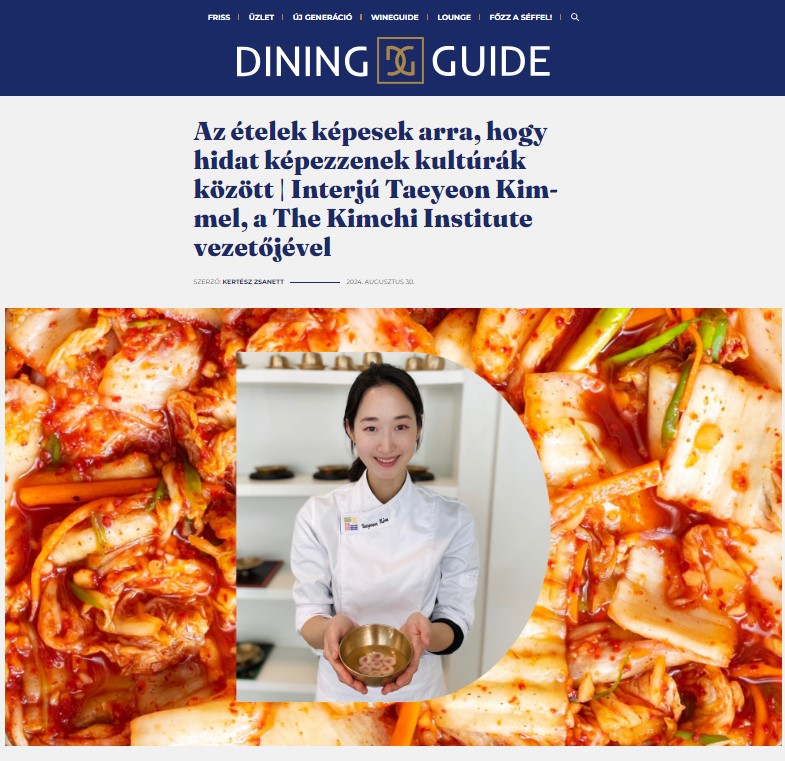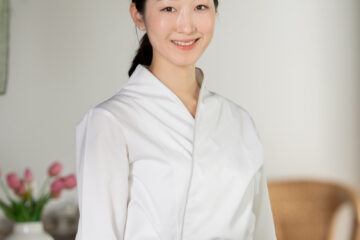Interview with Dining Guide (high-end food magazine in Hungary)
Taeyeon had an interview with Dining Guide which has been published online.
Dining Guide is the trendy high-end food magazine in Hungary.
During the interview, Taeyeon talked about kimchi, the past, present and the future, but also her mission through The Kimchi Institute, as well as Korean cooking and about her upcoming book!
Read the article here (in Hungarian)
Check out Taeyeon’s Kimchi recipe here (in Hungarian)
Below is the translated version in English.

The mission of The Kimchi Institute is to introduce and promote Korean culture around the world. Could you tell me more about your work?
I consider it my mission to bring the richness of Korean culture to as many people as possible in Europe. I organize and visit various events, in May I visited the Gourmet Festival in Budapest, where I presented a Korean dish, and last fall I assisted the visit of Buddhist monk Jeong Kwan, who presented Korean temple dishes.
Gastrodiplomacy – that is, building cultural relationships with the help of food – promotes various international collaborations with Korean embassies, cultural centers, local, European gastronomic and other organizations of other countries. Thanks to these collaborations, we share not only food and food culture, but also Korean traditions and heritage, which are unique and capable of bringing people closer together.

To what extent do your own childhood experiences and authentic Korean family traditions related to gastronomy influence your work?
Coming from a family whose gastronomic traditions are deeply rooted in Korean culture, I have always preferred being close to nature and healthy food. Through my upbringing, I learned how important seasonal food is, how important it is to follow the rhythm of nature in cooking and eating. I learned what edible wild plants there are, how vegetables can be used from their roots to their leaves, how important the art of fermentation is. These knowledge acquired as a child organically shaped how and what I share today from Korean cuisine and culture, which is primarily based on local, seasonal ingredients. In addition to family traditions, I was greatly influenced by Korean Buddhist practices, which later joined my life. For years, I worked and learned from great masters like Jeong Kwan, who made my culinary philosophy richer and more complete, and deepened my respect and admiration for nature and food.

What are the most important pillars of Korean gastronomic heritage for you?
Among the many traditions that are infinitely dear to me, fermentation is the closest to me. Fermentation is a cornerstone of Korean cuisine, and the iconic kimchi is just the beginning. Authentic Korean flavors include the use of jang, a bean-based fermented sauce, or gochujang (Korean chili paste), ganjang (Korean soy sauce), and doenjang (Korean soybean paste). These ingredients add umami flavor to food and contain vegetable protein. What I find really fascinating about Korean fermentation is the wild fermentation, which means that the food is made without yeast or artificial starters. Korean fermentation relies on local microorganisms, wild yeast, wild koji, which are present in the plants or in the environment. This type of wild fermentation on the one hand results in more special flavors, and on the other hand, it gives us space to take up the rhythm of nature.
What exactly is the history of kimchi and how has its importance in Korean culture evolved over the centuries?
Did you know that kimchi only became red after the 18th century? The fact that the history of kimchi goes back thousands of years is a relatively recent change. Kimchi evolved from vegetables pickled in salt or soy sauce to what we know today. The chili pepper played a significant role in this development, because thanks to its anti-oxidizing ability, much less salt is needed during preservation. Thanks to chili, some kimchi can be preserved for up to three years or more.
Chili opened the door to the addition of other protein-rich ingredients, we can use fish sauce, fresh seafood, or even bone broth, which all help to keep the preserved vegetables crunchy. Last but not least, these ingredients add new flavors and textures to kimchi, making it so truly irresistible. Nowadays, when more and more people around the world know about kimchi, a lot of different herbs are used to make it – basil, asparagus, chayote (squash) are just a few of them.

In several Asian countries, including Korea, the seasons are divided into a total of twenty-four micro-seasons following the changes in nature. How does this unique approach influence kimchi-making habits and other Korean culinary practices?
The twenty-four micro-seasons actually act as a guide, so we can see even better what is happening in nature, and we can prepare for a shorter availability of each raw material. Of course, each micro-season has its own characteristics, we have certain foods that we eat specifically in a specific period. For example, during Ipdong, at the beginning of winter, around the middle of November, we make a large batch of kimchi made from cabbage. The process is called kimjang, and in Korea, as much kimchi as possible is stored at this time to last through the cold months. By the way, there are more than two hundred and fifty different types of kimchi, an extremely diverse dish. In essence, it can be made from any available vegetable, each type of kimchi celebrates the individual seasons and micro-seasons. In the spring, we make kimchi from green onions or wild greens such as dandelions, and in the summer we use cucumbers and tender radishes. Each season is a new opportunity to discover a different type of kimchi.
As fermentation becomes more popular around the world, many people have started making kimchi at home. What’s the secret to good kimchi? Can you give us some tips?
Autumn is approaching, and now is the best time to make the classic baechu kimchi, i.e. Napa cabbage or Chinese kale kimchi, as the colder months bring out the sweetness of the vegetable. The secret of good kimchi rests on two factors: proper marinating (the vegetables must be marinated in salt as a first step) and the fermentation conditions. The Chinese kelt is salted with 8-10% salt by weight, which kills all the bacteria that can spoil the kimchi. After the vegetable has released enough moisture, rinse it two or three times to wash off the excess salt.
The fermentation of kimchi works quite differently than when we make sauerkraut. Fermentation takes place at a lower temperature – this is when the lactic acid bacteria form the juicy, spicy flavors. It’s worth leaving the kimchi at room temperature for a day or two to start fermentation , then put it in the fridge to ripen further at a lower temperature. Another piece of advice is that when you put the kimchi, don’t squeeze the vegetables as much as you do when you make sauerkraut, but rather gently twist them together. I have a very easy kimchi recipe in my upcoming book, I hope many people will experience the joy of making kimchi at home through it.
Kimchi is the cornerstone of Korean gastronomy – how much do modern culinary trends affect the development and future of kimchi?
I like to observe the exciting solutions that give kimchi a new look by using regional vegetables, ingredients and techniques. Everything can be made into kimchi, and as one of my favorite food journalists at NYT Cooking said, “kimchi actually functions as a verb, everything can be made as kimchi” (in English: “you can ‘kimchi’ everything” – ed.). As I previously told you about how the addition of chili changed kimchi and transformed it into what we know today, kimchi continues to evolve. It adapts to the changes in the world while staying true to its roots. Personally, I also really like to experiment with different local and seasonal European ingredients.

It is often said about kimchi how good it is for our health. Are there any recent new research results that deal with this topic?
It is extremely important to me to always be up-to-date on research on the health effects of kimchi, and more and more evidence is being found of its positive effects on our health. I recently read an interesting research from the state-funded World Institute of Kimchi, in which they wrote that the daily consumption of kimchi helps to reduce the chances of obesity. While it is very important to live and eat in a balanced and healthy way, these research results are very important and decisive. It is exciting to see more and more research proving the beneficial effects of kimchi on our health.
Have you been to Budapest several times, what similarities have you discovered between Korean and Hungarian cuisine?
I visit Budapest relatively often, and every time I discover some new similarity between the cuisines of the two countries. The last time I encountered pickled cucumbers, I saw that there are many similarities between pickling and preservation habits. In summer, you can often find oi-ji, fermented cucumbers in large jars, in Korean markets. I also really liked the fact that Hungarians use the juice of pickled cucumbers and make soup from it – this is also a similarity, because Koreans also use the juice of kimchi. Another similarity is the active use of red pepper and garlic, the fact that both countries love their soups, and the fact that both Korean and Hungarian cuisines use animals from head to tail, and they like to eat offal.
What are your travel plans in the near future?
Autumn holds a lot of excitement. My book ‘Seoul Budapest’ is published, which is about the pairing of Korean food and Hungarian wine. I worked on it with renowned wine expert Ágnes Herczeg, who is very dedicated to Hungarian wines. The exciting thing about Korean food is that it suits certain moods and occasions. When I drank Hungarian wine with Korean food for the first time in my life, I felt that it was a perfect combination – the flavors and characters fit together perfectly. One of my memorable discoveries, which is also included in the book, was the meeting of kimchi-jeon – a crispy, sour kimchi pancake with mangalica bacon – and kékfrankos. This pairing will instantly transport you to a rainy day. Pancakes are often eaten by Koreans on rainy days, some say that the pattering of raindrops on the ground resembles the sizzle of pan-fried pancakes.

Can you tell me more about the new book?
The book features iconic Korean recipes, wine pairings and stories. Trilingual – Hungarian, Korean and English. I was greatly influenced by Hungarian wines, I remember the first time I tasted Tokaji Furmint or Bikavér – I was impressed by their complexity and minerality. I trust that this book will also help to bring Korean cuisine closer to Hungarians, and Hungarian wines to Korean culture. On October 5-6, there will be a big Korean cultural festival in Budapest, the 2024 Mokkoji Korea – this is actually one of the biggest international Korean cultural events, and thanks to the Korean Cultural Center in Budapest, it can be in Budapest this year. At the festival, I will hold a kimchi-making workshop, and there will also be a cooking demonstration where I will make kimchi from Hungarian seasonal ingredients, such as paprika. Together with Ágnes Herczeg, co-author of the book, we will talk about the pairing of kimchi and Hungarian wines. It will be a very exciting event, with a variety of programs, and it will be worth visiting.
Photos: The Kimchi Institute | Taeyeon Kim | Korean Cultural Center | Balázs Smodits





0 Comments